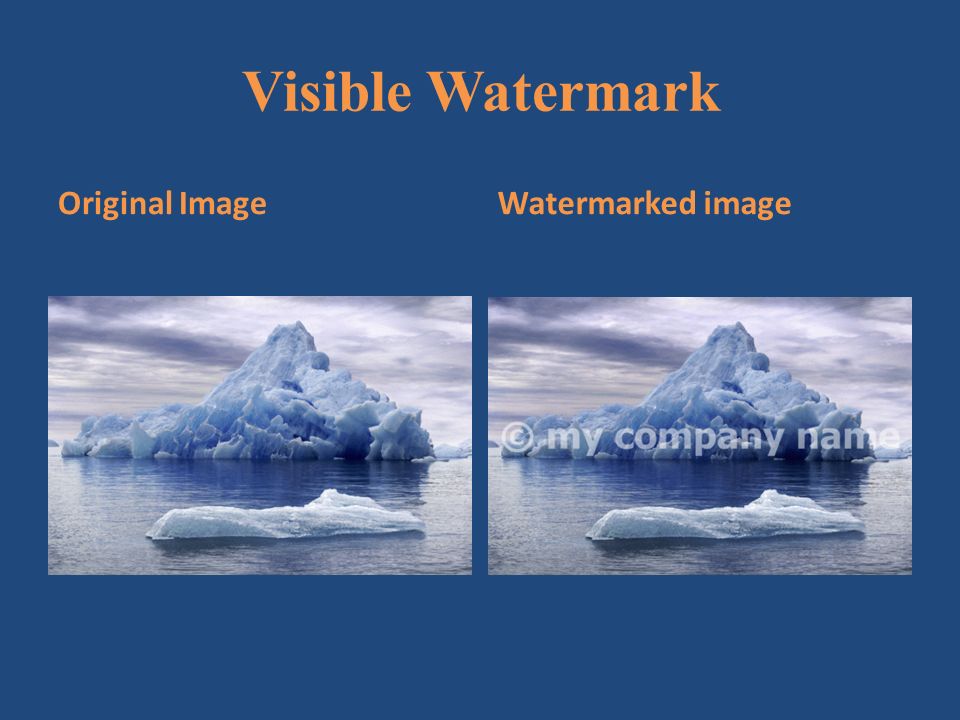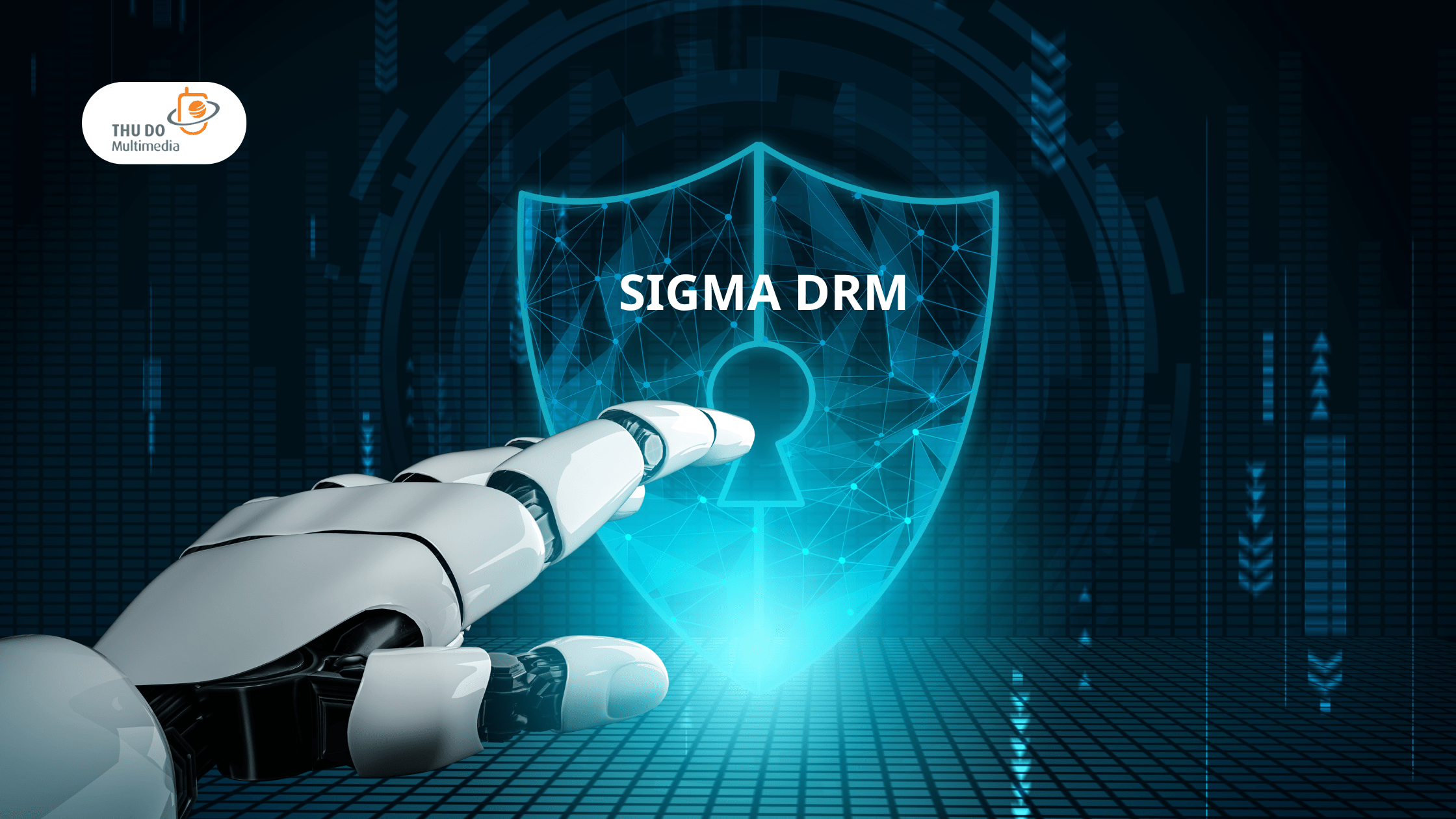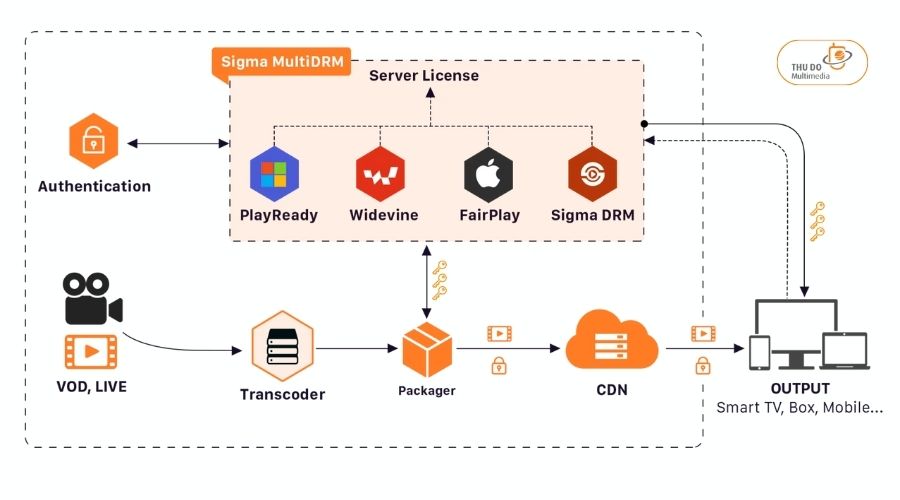Have you ever watched a blockbuster movie that was leaked online before it was officially released? The feeling of the filmmakers at that time must have been like being “robbed of their brainchild”! That’s why watermarking technology was born, like a “ninja” to protect creative works from “idea thieves”.
Video piracy is becoming an increasingly serious problem in the world of online entertainment. In the sports industry in particular, this situation is causing worrying consequences.
According to a study by Parks Associates, the rate of users who pirate movies and TV shows online in the US is expected to increase from 22% in 2022 to 24.5% in 2027. This shows that the demand for illegal content is increasing.
What is watermarking? Do you understand it correctly?
Simply put, watermarking is the process of embedding an identifying mark (visible or invisible) into an image, video, audio file, etc. Imagine you are marking your territory. If someone tries to “steal” your work, this mark will help you easily identify the source of the theft when there is a warning sign on the server.
2 Most Common Types of Watermarking
Visible Watermarking
is the most recognizable and simplest technique, in which the watermark is placed directly on the original content, easily recognizable by the naked eye. Normally, the watermark will be a logo, text or image that is blurred or transparent so as not to affect the aesthetics of the work too much.

However, visible watermarks have certain limitations because they are easily removed or covered with photo editing tools. Therefore, “theft” can still occur even when the logo is attached to the business’s product.
Invisible watermarking
is a more sophisticated method in which the watermark is embedded into the pixels of an image, the audio samples, or the data bits of a file in a way that is difficult to detect. Extracting the invisible watermark requires specialized algorithms and software.
This method has the advantage of not affecting the quality of the original content and is more difficult to remove than visible watermarks. However, implementing invisible watermarks is more complex and requires specialized knowledge of signal processing.
These two methods are really effective, and their role and significance for digital content today are well researched.
The Importance of Watermarking for Business
If you want to protect the copyright of your digital content after posting it on an online platform, understand the important roles of watermark for your business products/services:
Copyright protection
The core function of watermarking is to protect copyright. By embedding a recognizable identifier (such as a logo or brand name) into digital content, businesses can legally prove ownership. This is crucial in preventing others from claiming ownership of your products.
Moreover, adding watermarks to digital products helps enhance brand recognition. When customers see your logo or name on each product, they are more likely to remember and recognize your brand. This not only increases professionalism but also enhances the credibility and reputation of your business in the market.
If you are a professional photographer, adding a watermark to your photos helps protect them from being used without your consent. At the same time, every photo with your logo helps promote your brand to a wider audience.
Preventing illegal copying
Illegal copying of digital content is a major issue in the online environment. Watermarks act as a protective layer by making copying more difficult. When users download content that includes a watermark without the owner’s permission, they cannot use it legally, or its quality will be significantly reduced due to third-party software used to remove the watermark.
This significantly reduces unauthorized copying and protects the true value of the business’s products. Furthermore, watermarks may discourage those attempting to copy, as removing the watermark is not easy and will degrade the product’s quality.
Benefits of Preventing Copying:
Protects the value and quality of your brand in the eyes of customers.
Reduces revenue loss caused by illegal copying of products.
Ensures that your products are not used for unlawful or undesirable purposes.
Track usage
n addition to protecting copyright and preventing copying, watermarks also help businesses track and manage the distribution of their content. When a digital product (such as an image, video, or document) is shared without permission or downloaded from unreliable sources, the watermark can help identify the origin of the leak, allowing timely action.
Moreover, modern watermark technology enables the tracking of usage metrics and the extent of content distribution. This allows businesses to better control their intellectual property, ensuring that products are used only within legal and authorized boundaries.
Today, the application of watermarking has become popular in many areas of life
In the entertainment industry, including movies, videos, TV shows, etc. Reality TV shows often embed watermarks in recorded footage to prevent unauthorized rebroadcasts on other TV channels or online platforms.
The film producer 20th Century Fox used watermarks to protect the copyright of trailers and behind-the-scenes images of the film. These watermarks are usually the studio logo or the film name placed in the corner of the image or in the moving frames.
It is also widely used in the publishing industry to protect the copyright of books, magazines, documents or to protect online lectures in online courses. Online learning platforms such as Coursera and Udemy often embed watermarks in video lectures to prevent copying of courses and commercialization.
In the music industry, platforms such as Spotify and Apple Music have used watermark to manage the music copyrights of artists, allowing only subscribers to enjoy songs, playlists of idols or the latest music. In music, copyright is very strict, just violating music copyright will cause the video to be removed or muted.
Gaming industry: Watermarks are used to protect digital game assets, such as 3D models, textures and sounds. Copyrighting games is not copied and plagiarized.
What will be different about the future of watermarking?
The future of watermarking is promising thanks to the development of artificial intelligence (AI). The application of AI to the process of creating and detecting watermarks will bring significant breakthroughs:
Creating smart, complex, hard-to-detect and highly customizable watermarks. Instead of simple, static watermarks, AI can create dynamic watermarks that change over time or context, enhancing protection.
Integration with other technologies: Watermark will be more deeply integrated with technologies such as blockchain, to create a more comprehensive and reliable copyright protection system. Blockchain can help store watermark information securely and immutably, creating a digital copyright registry.
Or application to new fields such as virtual reality, augmented reality and the Internet of Things. For example, watermark can be used to protect 3D models, virtual reality experiences, or sensor data. Watermark is not only a protection for conventional digital products, but in the future, it will be powerful and protect all areas of technology.
The difference between DRM and Watermarking
DRM and watermarking are separate but complementary strategies used in the field of video streaming security. DRM acts as a “full-fledged fortress,” protecting digital content by encrypting it and controlling access through licensing mechanisms. Its main goal is to prevent unauthorized viewing, copying, or distribution.

In contrast, watermarking is a sophisticated but powerful technique that involves embedding invisible marks directly into content, allowing traceability in the event of a leak or unauthorized sharing. While DRM focuses on restricting access, watermarking acts as a forensic tool, allowing the source of unauthorized distribution to be identified.
The key difference lies in their primary functions: DRM is the “gatekeeper,” ensuring that only authorized users can access and use content, while watermarking is the “detective,” leaving an indelible trace for identification after the event. DRM operates secretly in the background, while watermarking can leave a faint trace that can be detected if actively searched for.
A combination of both technologies is often applied, leveraging DRM for strong access control and adding watermarks for traceability, creating a multi-faceted defense against the multi-faceted challenges posed by unauthorized access and distribution in the dynamic video streaming landscape.
Secure your streaming content today!
As the digital landscape continues to evolve, watermarking continues to be valuable in protecting your digital content from unauthorized theft. Helping businesses protect their brainchild from the “dark universe”.
Recognizing the need for strong content copyright protection, Thu Do Multimedia has developed Sigma Watermarking and Sigma DRM solutions to fulfill the mission of protecting digital content copyright.
Introduction to copyright protection solutions at Thu Do Multimedia
Sigma Watermarking Solution
Sigma Watermarking is our popular digital music solution. Sigma Watermarking is used to mark (digitally sign) when distributing or deriving a musical work, from which it is possible to easily trace pirated music or track the distribution and use of the work.
Sigma Watermarking can add watermarks to music products or insert hidden images into sounds to protect copyrights for artists. This is a product dedicated to the music industry of MCM businesses.

Musician Le Minh Son said that he and his colleagues have worked hard to develop the MCM Online Music Copyright Ecosystem – the first music copyright protection platform in the digital environment in Vietnam in February 2022. Therefore, although he is an artist, the musician is not afraid of copyright protection issues when putting the album Tinh – Yeu troi bo doi on online music platforms in addition to the traditional physical method.
Thanks to the support of Sigma Watermarking, MCM released the album on 52 online music platforms worldwide, including the largest platforms such as Apple Music, Spotify, Amazon Music, Alibaba, Nhaccuatui, Zing MP3, MCM Music… from December 1, 2022 without worrying about copyright infringement anymore.
Sigma DRM – Complete control of digital copyright for all multi-industry businesses
When it comes to digital copyright protection, Thu Do Multimedia’s Sigma DRM solution cannot be ignored. It is a powerful, resilient solution to preserve business content such as movies, videos, audio, etc.
Why do businesses need Sigma DRM solutions?
Comprehensive digital data management and protection
With Sigma DRM, businesses can set specific access rights for each user, ensuring that only authorized people can access documents, videos or other important digital assets. This not only protects content from unauthorized copying but also controls how that content is used and distributed.
Protect Intellectual Property and Increase Profits
With Sigma DRM, businesses not only protect their digital assets, but also optimize their intellectual property. This means minimizing the damage caused by copyright infringement, while increasing profits from the legitimate exploitation of digital assets.
Thu Do Multimedia’s comprehensive partner is VTVcab On, thanks to the implementation of copyright protection with Sigma DRM, the VTVcab ON OTT platform has reached more than 6 million downloads and more than 400,000 monthly users. Protecting high-quality content packages such as from K+, Box, VTVcab, and even famous Hollywood movies has helped VTVcab not only completely prevent copyright infringement but also increase customer trust and satisfaction.
Comprehensive control across all platforms
A prominent advantage of Sigma DRM is the ability to control content across multiple platforms and devices. Businesses can set limits on access time, number of devices, or content resolution. This is especially useful when implementing marketing campaigns or when distributing digital content to customers.
How Sigma DRM Works
Sigma DRM operates by encoding and packaging your applications, ensuring that they can only be accessed and used in accordance with your terms and conditions. This prevents unauthorized distribution and modification of your content. Additionally, Sigma DRM can be applied at different stages of the application lifecycle, providing comprehensive protection: Software, mobile app,..

Conclude:
Protecting digital copyright is the responsibility of digital creators, because it is beneficial to businesses and helps maintain the longevity of digital products. A product can only be reinvested many times when it is protected and controlled by the author himself.
Thu Do Multimedia is very proud to be able to develop the Sigma DRM solution to help businesses no longer lose revenue and effort in creating or releasing digital products.
Cooperate with us today, to join hands in developing and pushing back the “free use” phenomenon, because we can certainly help you achieve that in the easiest and most comprehensive way.


Recent Comments